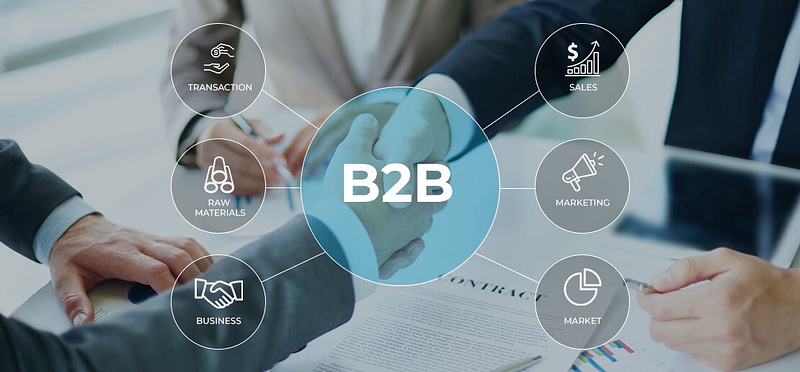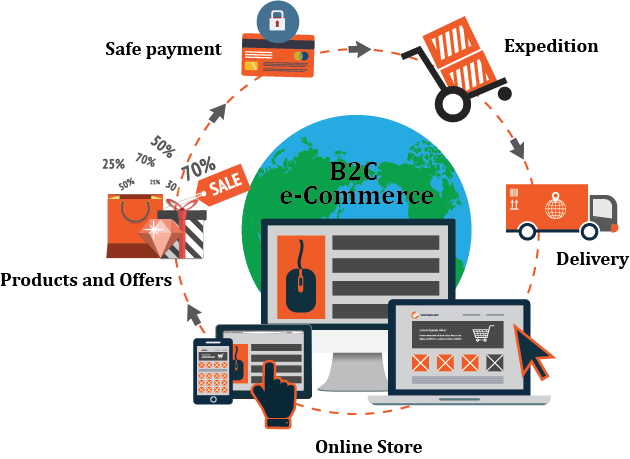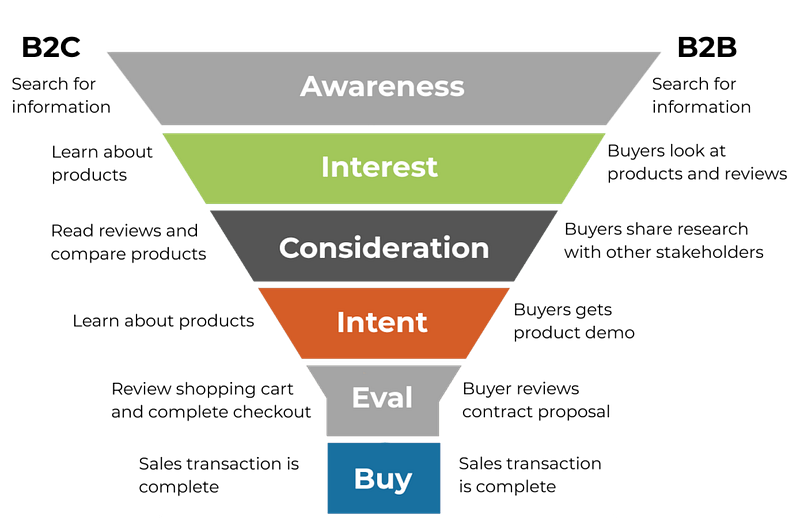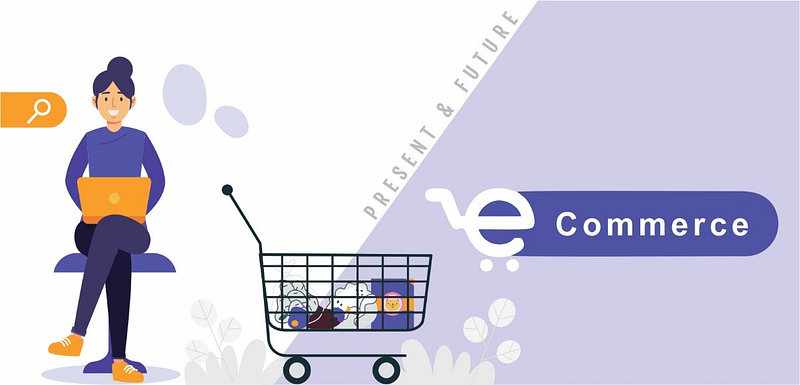Whether you’re selling the same goods to both businesses and individuals or different interests to B2B and B2C customers, one of the most critical factors in eCommerce website design is figuring out what sets your site apart from the competition. What can your site do that other can’t? How will your site stand out from the crowd?
Using an eCommerce website to sell your products or services can be very lucrative, but knowing which type of eCommerce site best suits your company’s goals is essential.
To develop an eCommerce website that successfully markets your products and services, look no further than this guide on B2B vs. B2C eCommerce websites.
Latest eCommerce Industry Stats
Online shopping has become a necessity for retailers worldwide. There is no question that the digitization of everyday life will continue indefinitely.
Image Source: Shopify
Here are some of the latest eCommerce industry stats:
- In 2021, the world’s retail e-commerce market grew by 50% over four years. By 2025 it’s estimated that this will reach around 7 trillion dollars
- In 2020, global eCommerce sales were reached $4.28 trillion and now projected to reach $6.54 trillion by 2023
- The US is the largest eCommerce market in the world, followed by China, Japan, and the UK
- In 2020, 1.92 billion people worldwide purchased goods online
- By 2040, 95% of retail sales are expected to be online
- Mobile commerce accounts for 72.9% of all eCommerce traffic and is only expected to grow
- In 2021, the average order value for an eCommerce transaction was $205.26
Unleash the full potential of your online store with ValueCoders, the trusted provider of customized e-commerce solutions for businesses of all sizes.
Why Is There A Need For Ecommerce Websites?
There is no denying that eCommerce websites have taken the business world by storm. In today’s digital age, having an online presence is essential for an eCommerce app development company that wants to stay competitive.
eCommerce websites provide a convenient way for customers to purchase products and services from the comfort of their own homes. It also allows businesses to reach a wider audience, increasing sales and profits.
Have A Look At More Reasons For Adopting eCommerce Websites In Today’s Age
- eCommerce websites are cost-effective, as businesses do not need to spend money on physical storefronts or brick-and-mortar locations.
- It provides businesses with the ability to track customer data and analytics. This information is further used to improve the customer experience and overall conversions.
- These websites are mobile-friendly as more and more people shop online using their mobile devices.
- It also offers a higher level of security for businesses and their customer’s data.
- Social media integration in eCommerce allows businesses to interact with customers and build relationships.
B2B eCommerce: A Brief

Image Source: Google
A business-to-business (B2B) transaction is when a company purchases products and services from another company for its use instead of resale.
Small businesses often rely on larger companies to provide goods or services they cannot produce or deliver themselves. For example, a restaurant may not make all of its menu items but buy food from local producers and vendors.
Pros & Cons of B2B
B2B eCommerce is a large part of the eCommerce industry. There are many benefits to using eCommerce websites for businesses, but there are also some drawbacks. Here are some pros and cons of B2B eCommerce:
Pros of B2B
- Increased reach: businesses can sell to customers anywhere in the world with an eCommerce website
- 24/7 availability: customers can purchase products or services at any time, day or night
- Increased convenience: customers can shop from the comfort of their own homes or offices
Get efficient and scalable B2B solutions with ValueCoders, your trusted partner for top-notch technology services.
Cons of B2B
- Requires a significant investment: businesses will need to invest in developing and maintaining an eCommerce website.
- Challenging to stand out: with so many businesses now selling online, making your eCommerce website stand out from the competition can be difficult.
- Challenging to build trust: customers may not have the same level of confidence in an online business as they would in a brick-and-mortar business, so companies must work hard to build trust with potential customers.
Must Read: A Comprehensive Guide To Create An eCommerce App From Scratch
B2C eCommerce: A Brief

Image Source: Google
This typically refers to a business that focuses on selling its products directly to end-users. For example, Amazon is B2C since it sells books and other items directly to consumers.
Most notably, B2C sites have more complex user personas because they deal with people from all walks of life who might have wildly different needs and expectations from your site.
As such, B2C sites usually require more product-specific information and customer support options (such as live chat) because many visitors will likely need help deciding what to buy or how to use your product effectively.
Pros & Cons
B2C eCommerce allows businesses to sell products and services to consumers online. There are many benefits to B2C eCommerce. However, there are also some drawbacks to B2C eCommerce, such as the potential for increased competition and the need for a strong marketing strategy.
Pros
- Reach: eCommerce websites have the potential to reach a global audience 24/7. This benefits businesses that sell products or services that can be consumed online.
- Cost: Setting up and running an eCommerce website is generally more cost-effective than setting up and running a brick-and-mortar store. You do not have to pay for physical space, inventory, or employees.
- Convenience: eCommerce websites are convenient for both businesses and consumers. Customers can shop online at home, and businesses can operate their stores from anywhere in the world.
Cons
- Security: Security is one of the biggest concerns for businesses and consumers. When dealing with sensitive information like credit card numbers, it is essential to ensure that your website is secure.
- Lack of Personal Connection: Another downside of eCommerce is that there is no personal connection between the business and the consumer. If you sell products requiring customer service or support, this can be an issue.
- Competition: The eCommerce industry is highly competitive. To succeed, you will need to have a well-designed website and offer products or services that are unique and in demand.
Get efficient and scalable B2C solutions with ValueCoders, your trusted partner for top-notch technology services.
Also Read: Transforming B2B eCommerce: A Closer Look at Leading Platform Offerings
B2B vs. B2C: How Do They Both Differ?

Image Source: Google
There are two basic categories of online commerce websites: Business-to-Consumer (B2C) and Business-to-Business (B2B). Here’s a breakdown of how they differ.
-> B2C sites focus on serving individual consumers, often through mass production and distribution of products. On the other hand, B2B sites are targeted at businesses that purchase products in bulk to resell them individually or use them as parts or components in final manufacturing.
-> Another significant difference is that B2C sites sell services while B2B sites sell physical goods.
-> The prices on a typical B2C site are usually set by the eCommerce app development company offering the product for sale, whereas with a specific B2B site, price quotes from different vendors can be compared against each other.
-> With a business-to-consumer (B2C) model, businesses sell directly to consumers. In a business-to-business (B2B) model, on the other hand, companies sell products or services to other businesses as opposed to consumers.
-> B2B website generally does not need an online store offering individual products. Instead, they can typically provide customized solutions through their site. A B2C website, on the other hand, needs to provide individualized items so customers can select exactly what they want from the site.
-> With a B2B website, you generally need employees with industry expertise to provide high-quality customer service. If you run a B2C website, however, you don’t necessarily need employees with deep knowledge about specific industries because you will be selling general products to everyone.
-> B2B sites generally cater more towards small businesses than large ones. They often have limited budgets and don’t have as much money to spend on marketing campaigns. On a B2C website, however, you might find more prominent brands advertising their products.
Also Watch this Video to Learn the Differences Between B2B & B2C:
B2B vs. B2C: A Comparison Based On Parameters
Most people assume that both eCommerce sites look the same, as they share many similarities, such as product listings, shopping carts, and shipping methods.
However, you need to know about the subtle differences between these two websites to optimize their performance and create a better user experience (UX).
Let’s take a look at the critical areas of difference between these two types of eCommerce sites.
Overall Purpose
B2C eCommerce sites are typically focused on generating sales, while B2B eCommerce sites are more concerned with facilitating transactions between businesses. This often results in different design approaches and different features being prioritized.
Target Audience
B2C eCommerce sites are generally designed to be accessed by individual consumers, while B2B eCommerce sites are meant to be used by employees of other businesses. This can affect the language used on the site and the payment methods offered.
Sales Process
B2B transactions are often more complex than B2C, involving multiple decision-makers and a longer sales cycle. B2B eCommerce sites need to be designed to accommodate this process, with features like quote requests and account management.
Target Market
When you start building your website, one of your most significant decisions will be how to define your target market.
For B2B companies, choosing a niche is less critical than it is for B2C eCommerce companies. Some B2B sites serve multiple industries or markets within a single sector.
That’s because their customers don’t buy products — they believe in solutions that solve problems and help them achieve their goals.
Instead of focusing on demographics and psychographics, often used in consumer marketing, many B2B companies use behavioral data to understand their customers’ needs and wants.
Website Structure
The structure of a B2B website is entirely different from that of a B2C website. B2C sites use user experience design and pop-ups; their counterparts are designed to be purely transactional.
Without an individualized approach, selling online will always be harder in B2B than B2C. Once the customer has purchased something, the sale should not be considered complete.
There should always be more opportunities for engagement through social media or email marketing campaigns, ensuring that people who bought products get value out of them after purchasing them.
A successful B2B site also includes detailed product descriptions and interactive tools such as chatbots or contact forms, so customers can find what they need without the hassle. There are tips on SEO strategies for eCommerce websites that can help to better structure your page
Information Architecture
Most business owners may not even know that a website can have an architecture.
But it does!
While both types of websites should be easy for users to navigate, some key differences between their structures have everything to do with audience and purpose.
It is no wonder businesses choose B2B over B2C in many cases, but what makes one stand out from another? What makes one more successful than another?
Also Read: Top eCommerce Development Companies In India To Change Business Fortunes
Here are some generalizations about each type of site
1) Audience & Purpose — A B2B site has different needs than a B2C site regarding purpose and design. For example, while the primary goal of a B2C site is to create revenue through selling products and services, the goal of a B2B site will be to build relationships with other companies or professionals.
2) Attention Spans — B2C sites can get away with asking for less input from users because shoppers usually aren’t shopping around too much before making purchases.
However, in B2B situations, you’ll need to ask more questions up front to give your potential customers information they need about your product or service so they know whether or not they want to do business with you.
3) User Experience — Remember how audiences use their computers and devices when designing a website. If you are creating a B2C website, remember that people are looking for something specific, fast! They don’t have time to read long paragraphs or watch videos. They want what they came for.
In contrast, B2B websites should focus on providing detailed content that offers value to readers; otherwise, you risk losing them altogether by overwhelming them with too many options and choices.
Content Distribution Methods
You can reach many potential customers by using a combination of distribution methods. You must implement these strategies early in your launch, whether it’s pay-per-click ads, social media, search engine optimization (SEO), or email marketing campaigns.
Things You Need to Consider When Making Your Decision:
- What are your company’s goals?
- Is there room for growth?
- What is your customer base?
- What is your average order size?
- Do you have a brick-and-mortar location nearby where people will come to purchase items from your store instead of ordering them online?
- Are you looking to open up shop locations across the world?
If so, then B2C may be right for you.
Is your primary customer base local or global?
Do most of your orders typically contain small items or large ones?
If most of your orders contain large items, consider B2B because shipping costs could eat into profits with each order.
If you’re looking to build a customer base internationally, then B2C might be best because it has a more significant international reach. It all depends on what kind of business you want to create and what type of customer you want to attract.
Transform your online business with ValueCoders' expert eCommerce services and drive growth, efficiency, and success.
What is alike in both (B2B vs. B2C)? — Lead Generation Techniques
Business to business (B2B) commerce may seem like a world apart from business to consumer (B2C) commerce, but one crucial thing remains consistent across both channels: LEADS.
Leads are what every company wants, and that includes online businesses. Whether you’re selling cars or canned vegetables, a website visitor can be your next customer — if you know how to capture their information and convert them into leads.
Capturing new customers can be difficult without an effective lead generation strategy. One of the best ways to generate leads is through social media campaigns, creating content people want to share with their networks and providing incentives for anyone who does so.
What Is The Future Of The Ecommerce Industry?

Image Source: Google
The ecommerce industry is booming and is only expected to grow in the coming years. This growth is being driven by some factors, including the increasing popularity of online shopping, the proliferation of mobile devices, and the rise of social media.
You May Find This Interesting: WordPress Vs Shopify: A Detailed Comparison For ECommerce Store
Here are three things to keep an eye on
1. The e-commerce market will continue to grow
This is good news for businesses that are already established in the e-commerce space, as well as those that are looking to enter the market. The growing e-commerce market presents a massive opportunity for businesses to reach new customers and sell more products.
2. Mobile commerce will become more important
Mobile commerce, or m-commerce, is already a big part of the e-commerce market. And it will only become more critical in the years to come. Customers are increasingly using their smartphones and tablets to shop online. EMarketer projects that m-commerce will account for nearly half of all e-commerce sales by 2021.
This trend is driven by the increasing number of people who own mobile devices and the improvements in mobile technology, such as faster internet speeds and better payment options.
3. Social media will play a more prominent role in e-commerce
Social media is already a big part of e-commerce, but it’s expected to have an even more significant impact in the years to come. More and more businesses are using social media to reach their customers and promote their products. And with the rise of social commerce, we’re seeing that consumers are increasingly using social media to make purchases.
Conclusion
Now, you must be hoping to maximize conversion rates for your business. Understanding the differences between B2B and B2C sites should be essential to your design process.
At ValueCoders, we’ve designed and developed websites for all types of businesses, from eCommerce sites to those geared towards B2B leads. Hire eCommerce developers from us and leverage the benefits of eCommerce Development Services for your next project.





